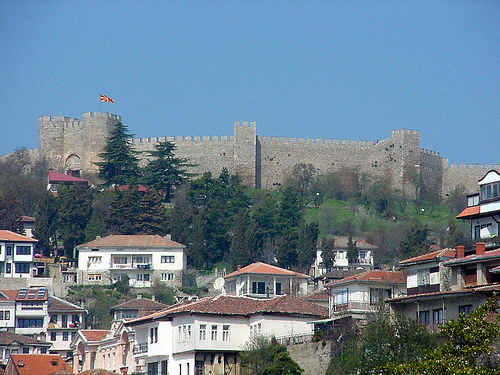

Location: Ohrid Map
Constructed: 11th century
Samuel's Fortress located in a town of Ohrid was an original capital of the First Bulgarian Kingdom during reign of King Samuel. Although the first military fortifications here were constructed in the 4th century BC by Phillip II of Macedon, father of Alexander the Great. Titus Livy called this city Lihnidos in the 3rd century BC and described its walls as mighty and well defended. Apparently it was a major citadel at the time able to withstand major sieges. It became handy as a Roman Empire began to fall apart barbarian tribes flooded into a region. In 479 armies of Goths under leadership of king Theodore tried to capture it and failed despite numerous advantage. Slavs settled here and eventually formed their country that became known as a Bulgarian Kingdom. King Samuel turned into his capital and greatly strengthened military fortifications of citadel's defences in the early 11th century. Most of population of the medieval Ohrid used to live within the walls of the Samuel's Castle. With the arrival of the Ottoman Turkish armies the city grew in size and Ohrid's citizens settled at the base of the hill, leaving medieval walls behind. Today the fortress is open to the public. It is well reconstructed and well maintained, however be careful when you climb walls and towers of the medieval structure.
Samuel Fortress is considered one of
the largest fortifications preserved in Macedonia. It was first
mentioned by the historian Titus Livy in the 3rd century BC, while
it was still a fortress in the city of Lychnidos.
As early as
the fifth century AD, Ohrid was mentioned by Roman historians as a
city with fortresses, which like other Roman cities in the Balkans
was defended from the invasions of the wandering tribes, during the
great migration of peoples in the IV and V century. The conquered
Ohrid in 479 rejected the siege of the Gothic king Theodoric the
Great.
In later centuries Byzantium used these fortresses and
certainly expanded them. The Slavs enter Ohrid without any major
demolition. But Ohrid, as the capital of Samuel's Kingdom, has
renewed and quite strong ramparts. The present form of the fortress
dates back to the time of Tsar Samuel, although there are records of
demolition and repair of the fortress by the Ottomans and
Byzantines.
After the transformation of Samuel's state into a
political and ecclesiastical seat, Ohrid became a medieval
metropolis. Until the end of the XIV and the beginning of the XV
century, the inhabited city of Ohrid lived within the city walls.
After Ohrid was occupied by the Ottoman Turks, with the arrival of
colonists from Asia Minor in the 15th century, there was an
expansion of the population through the lower parts. The last ruler
of Samuel's fortress was Xheladin-bey.
The fortress today
The fortress today represents the highest part of Ohrid, which rises
100 meters above the level of Lake Ohrid. Throughout history, it has
undergone numerous repairs, and this can be seen on the Upper Gate,
in which numerous marble fossils with Greek and Roman inscriptions
are built, which originate from the ancient and Roman buildings,
which abound in this area.
The recent history of Samuel's
Fortress is linked to the great archaeological excavation of the
cultural strata inside it and to the rebuilding of its walls. The
research began in 2000, and many valuable finds were discovered,
including the famous "Golden Mask and Golden Glove", dating from the
5th century BC.
The highest part of Ohrid is
covered with central walls that are 10 to 16 meters high as well as
defensive towers. One end of the outer wall descends obliquely to
the west to the coast of Labino. The other leg, heading east,
crosses the outer gate "Gorna porta", occupies the lower height of
the Ohrid hill in the locality of Deboj and from there to the south
descends obliquely to the lake.
The fortress bears visible
traces of frequent repairs. Under the partially demolished outer
layer in the inner walls there are horizontal layers of Byzantine
format bricks. In the walls of the upper gate there are many stones
with Greek inscriptions originating from the ancient buildings with
which this terrain is full. Today, the Ohrid Fortress is a trademark
of Ohrid and thus of Macedonia, many pages of the history and
culture of the Macedonian language through the centuries are
inscribed on it, which is an invaluable cultural source for our
Republic.